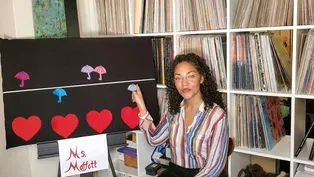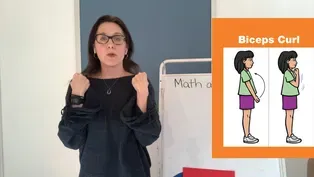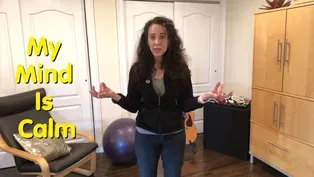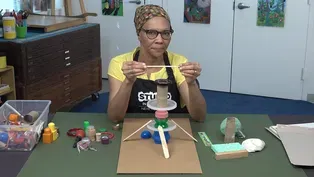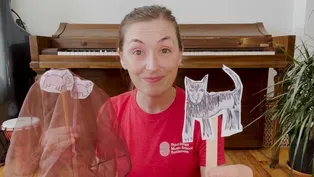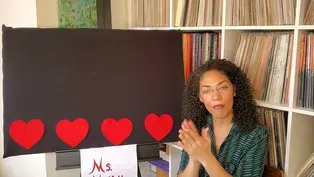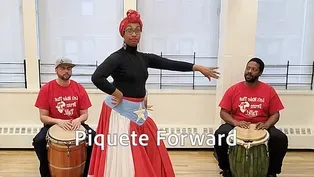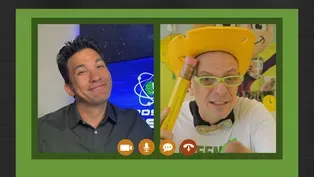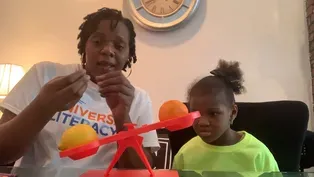
Can You Hear the Short “i” in Little?
2/8/2021 | 56m 37sVideo has Closed Captions
Code without a computer, breathe deeply, read BIG PAPA AND THE TIME MACHINE.
Code without a computer, make groups of objects equal, breathe deeply, read BIG PAPA AND THE TIME MACHINE, review short I, o, u, w, j, y, and v. LET’S LEARN helps children ages 3-8 with at-home learning. One-hour programs feature instruction by educators and virtual field trips.
Problems with Closed Captions? Closed Captioning Feedback
Problems with Closed Captions? Closed Captioning Feedback
Let's Learn is a local public television program presented by THIRTEEN PBS

Can You Hear the Short “i” in Little?
2/8/2021 | 56m 37sVideo has Closed Captions
Code without a computer, make groups of objects equal, breathe deeply, read BIG PAPA AND THE TIME MACHINE, review short I, o, u, w, j, y, and v. LET’S LEARN helps children ages 3-8 with at-home learning. One-hour programs feature instruction by educators and virtual field trips.
Problems with Closed Captions? Closed Captioning Feedback
How to Watch Let's Learn
Let's Learn is available to stream on pbs.org and the free PBS App, available on iPhone, Apple TV, Android TV, Android smartphones, Amazon Fire TV, Amazon Fire Tablet, Roku, Samsung Smart TV, and Vizio.
Providing Support for PBS.org
Learn Moreabout PBS online sponsorshipMore from This Collection
Video has Closed Captions
Read SCHOOL BUS and draw one, learn about prefixes and pitch, build sculptures. (57m 48s)
Running and Counting Both End in “ing”!
Video has Closed Captions
Move to improve, find the missing number, learn songs from Ghana, read ABUELITA’S SECRET. (58m 17s)
What Sound Does “aw” Make in Draw?
Video has Closed Captions
Read a story, discover "au" and "aw," learn about density, count, and move with music. (56m 58s)
Can You Find the Short “u” in Subtract?
Video has Closed Captions
Help Super Grover 2.0 solve a prickly problem, read ALL THE WAYS TO BE SMART. (56m 19s)
What Sound Does “gl” Make in Glove?
Video has Closed Captions
Play the glockenspiel, help Super Grover 2.0 make a cart move, read TWO WOOL GLOVES. (58m 9s)
Incredible Starts with Short “i”!
Video has Closed Captions
Solve problems with Super Grover 2.0, catch a rainbow, hear a piano sound like a cuckoo. (56m 9s)
What’s the Sound of “oo” in Book?
Video has Closed Captions
Explore animals’ form and function, sing about the 3 little pigs, read THE LITTLE BOX. (58m 15s)
We’re Reducing, Reusing and Recycling!
Video has Closed Captions
Learn all about rhythm and the number 9, read A BAG IN THE WIND. (56m 17s)
Video has Closed Captions
Learn to dance bomba and grow food in a city, read WOLF CUB’S SONG. (55m 20s)
How Many Syllables are in Invent?
Video has Closed Captions
Invent your own instrument, make 10 to add numbers to 20, read ONE GOLDEN RULE AT SCHOOL. (57m 36s)
Video has Closed Captions
Learn about the science behind mind reading, count shells, read MY BIG FAMILY. (57m 27s)
Which is Heavier: One Apple or Two Apples?
Video has Closed Captions
Defy gravity, learn secret code words for fast and slow in music, read WHOOO KNEW? (58m 5s)
Providing Support for PBS.org
Learn Moreabout PBS online sponsorship[upbeat music] - [Narrator] Ready to learn?
- Hi!
- Hi!
- [Narrator] It's time to share a story-- [shushing] Read and write-- - Let's read it back.
- [Narrator] Discover science, sing, [singing] play, and so much more.
- Cupcake!
- Very good-- - [Narrator] Stay tuned for lessons and activities.
- We're going to start making some words.
Isn't that fun?
[upbeat music playing] - [Narrator] Funding for this program was provided by The JPB Foundation.
[upbeat music playing] - Hello scholars and families.
My name is Dr. Todd.
I am delighted to be with you today to do a read aloud.
Following the read aloud, we will learn about making a text-to-self connection and a text-to-world connection.
The title of the read aloud is "Big Papa and the Time Machine."
the author is Daniel Bernstrom, the illustrator is Shane Evans.
What do you notice on this cover?
Okay, I notice an older gentlemen and a boy with a hat, they're both wearing hats.
So I'm really interested to find out what this book is going to be about.
Have you ever heard of a time machine?
Hmm, I'm going to think for a minute.
A time machine is a machine that takes you back into time to find out what happened during a certain period of history.
I can't wait to read this with you.
I will never forget that September time when I didn't want to go to school and big Papa came in his time machine to take us way, way, way back.
Do I have to go to school?
"Yes," Big Papa said.
"I just want to go home and watch TV.
"You scared?"
Big Papa said.
"I'm scared I'll miss you."
He turned the key and the engine revved.
"I think it's time I showed you something a long time ago."
I wonder what he's going to show him.
Little Rock Arkansas, 1952.
We took Big Papa's time machine to a long time ago.
"Big Papa, why that silver-haired lady holdin' that boy "tighter than tight?"
"He was leaving the home," Big Papa said.
"Needed to find him a job where you could eat fried fish "every night.
"Big Papa, that you?
"Yes," Big Papa said.
"You left your mama?
"Yes," Big Papa said.
"Was you scared?
"Scared to death," Big Papa said.
"Didn't have no job, didn't have no money or place to stay.
"But I thought you was never scared?"
Very interesting.
The boy is learning about when his grandfather got scared.
"No, been scared lots of times," Big Papa said, "but sometimes you got to lose the life you have "if you ever going to find the one you want.
"That's called being brave."
Chicago, 1955.
We took our time machine to when Big Papa worked in the sky on top of tall buildings wrapped in coats of smoke and ash.
"You couldn't wear a white shirt back then," Big Papa said, "if you do, it'd be black by the end of the day.
"All that soot in the air.
"You was so high up, wasn't you scared?
"Oh, I was scared," Big Papa said.
"Cars looked like toys and the wind would blow so hard "you'd think it'd carry you right away.
"Why did you work up so high?"
I'm wondering the same question.
Let's think in our brain why he was working up so high.
"I couldn't stand to stay on the ground," Big Papa said, "sometimes you got to walk with giants "if you're ever going to find out what you made of.
"That's called being brave."
So what two emotions have you learned about so far?
Let's think, or feelings, scared and brave, yes.
[upbeat music starts playing] Chicago, 1957.
We took our time machine to when Big Papa sat by himself in some boogie-blusey club.
"Mmh" Big Papa said, "hear those trumpets and them saxophones?
"They still make my bones want to swim."
Trumpets and saxophones are musical instruments.
"But why you not dancing?
"You see that angel dancing in a pink dress?"
Big Papa said, "Your Nana, mmh!
"She stole my heart with that pink dress."
Then Big Papa jumped into the crowd and his feet and arms swam with Nana's and they danced and danced and danced and Nana held Big Papa tighter than tight.
"I thought you was scared?
"I tell you I was scared," Big Papa said, "but sometimes you got to jump in an ocean of scared "if you're ever going to dance with an angel.
"That's called being brave."
You can think of a time you were brave.
Chicago, 1986.
We took our time machine to the day a sad girl left a baby in Big Papa's arms.
"I'm that baby?
"Yes," Big Papa said.
"Your mama left you here for a while, "but she never came back.
"No," Big Papa said, "she never came back.
"Was you scared?
"You was so little and I was so old.
"I'm sorry I made you scared."
Big Papa hugged me tighter than tight.
"Sometimes you got to love the unexpected "if you're ever going to find love at all.
"That's called being brave."
Little Rock, Arkansas, cotton fields, 1941.
We took our time machine to a long long time ago.
"Big Papa what are you doing here?"
A boy who just looked like Big Papa scratched letters on a piece of thin paper.
"Big Papa is that you?
Big Papa held my hand tighter than tight.
"Just watch.
"What are you doing with that paper?"
Said a man.
"I'm doing school."
The man pulled a fist full of cotton from his pocket.
"See this cotton and see that field?
"Look [indistinct] "This is your school."
The man took Little Papa's school paper and ripped it up.
"Give up school son, work, "that's all you're ever going to do," he said, "that's all we ever can do."
How is the boy feeling?
I'm sure he's very upset.
"Did you ever go back to school?
"No," Big Papa said.
"Does being scared ever go away?
"No," Big Papa said.
"You scared right now?
"Big Papa, you scared?
"Mmh," Big Papa said.
"Why you scared?
"I'm scared you're growing up too fast," Big Papa said, "and I already miss you."
I hugged Big Papa tighter than tight.
"But that's called being brave.
"Yes," Big Papa said, "that's called being brave."
The end.
I hoped you enjoyed this book.
What was your favorite part?
Okay, you liked when big Papa was in the field, excellent.
Okay, I'm going to tell you about the text-to-self and text-to-world connection that I'm going to have you make.
So if we look at this paper, we have text-to-self connection.
If we look up here, there's a picture of the book we just read, the arrow means to, and then I'm showing two boys.
It could have been two girls but I'm shown two boys right now.
And what I'd like you to do is think about what in the book reminded you of something in your life?
And I'm gonna model this right now.
So this book reminds me of my wonderful relationship with my grandfather.
We used to have great talks about life.
Also, this book reminds me about a time that I was scared.
My brother and I went to Coney Island and he wanted to go on the Cyclone with me and I was scared to do it.
However, I did it and I ended up loving it.
So I acted brave.
So I'd like you to make a text-to-self connection with a family member from this book.
Go ahead.
Okay, I really loved hearing what you said, I heard somebody talk about when they were brave, when they were scared, wonderful.
The other connection we're going to learn about is called text-to-world connection.
And if you see, we have the book here, it could have been any book, but obviously we're using this book now.
The arrow represents two, and then I have a picture of a hand holding a globe.
So a text-to-world connection is connecting the book to something that's happening in this world.
And my connection to the book is I want people to be treated equally, no matter what skin color.
Everybody deserves to be treated fairly and with respect.
So you can share your text-to-world connection.
Okay, I hear somebody talking about peace in the world, treating people fairly, not bullying.
Excellent!
So I hope you enjoyed this activity and I hope you continue to discuss this book with your family.
Remember, it's okay to be scared and it's okay to be brave.
They are emotions.
So think about times you were scared or brave in your life.
Thank you.
Have a wonderful day, goodbye.
- Hi movers and shakers.
This is Violet, and we're going to do a special dance today.
So I want everyone to either stand up or sit up really tall in your seat or on the floor and we're going to do the hokey pokey.
Are you ready?
♪ You put your left hand in ♪ ♪ You put your left hand out ♪ ♪ You put your left hand in ♪ ♪ And you shake it all about ♪ ♪ You do the hokey pokey and you turn yourself around ♪ ♪ That's what it's all about ♪ ♪ You put your right hand in ♪ ♪ You put your right hand out ♪ ♪ You put your right hand in ♪ ♪ And you shake it all about ♪ ♪ You do the hokey pokey and you turn yourself around ♪ ♪ That's what it's all about ♪ All right, you ready to put your leg in?
♪ You put your left leg in ♪ ♪ You put your left leg out ♪ ♪ You put your left leg in ♪ ♪ And you shake it all about ♪ ♪ You do the hokey pokey and you turn yourself around ♪ ♪ That's what it's all about ♪ ♪ You put your right leg in ♪ ♪ You put your right leg out ♪ ♪ Put your right leg in ♪ ♪ Then you shake it all about ♪ ♪ You do the hokey pokey and you turn yourself around ♪ ♪ That's what it's all about ♪ Bye guys!
[upbeat music playing] - Hello learners, it's so nice to see you again.
We're going to have a great time today with a few activities where we listen for the beginning sound in words, the middle sound in words, and then we're going to work with words sound by sound.
At the very end, we'll read and write a little together.
So let's get started.
Our first activity, you already know how to do this.
You're going to listen and tell me the first sound you hear in a word I say.
Say this word with me, whale.
What was the first sound that your mouth made?
[making wh sound] Here we go, I'm going to give you a few more.
How about vase?
Good, [making v sound].
Yuck.
Yes, [making y sound] Jade.
You got it, [making j sound].
Vine.
Yes, [making v sound].
How about yell?
You got it again, [making y sound].
How about web?
[making w sound] And jet.
Yes, [making j sound].
You just heard a few consonant sounds in the beginning of words.
You heard wh, j, y, and v. Now, let's see if we can break a few of those words up into each sound that we hear.
Say this word, web.
Let's break it up.
W e b.
Great, let's try another.
Say jet.
Let's break it up.
J e t. Yes, let's try yell.
Good, y, ell.
Last one, vine.
V, ine.
Nice work.
We just segmented words into the sounds that we could hear.
Okay learners.
Now we are going to listen for the middle sound in the word.
I'm going to say two words and you're going to help me figure out are those words the same or different?
What's going to change is the middle vowel sound.
Listen to these two words, rug, rag.
Are those words the same or different?
They're different?
Why?
Oh, because rug has uh in the middle and rag has a.
Look at my board, I'm going to make each sound.
R u g. The other word.
R a g. Yes, this changed, the middle vowel.
Let's do a few more.
Listen to these two words.
Rack, rake.
Oh, those are different.
Yes, rack, a.
Rack, rake, are they the same or different?
You're right, they're different.
Rack had ah in the middle and rake had a.
How about these two?
Son, son.
You're right, they're exactly the same.
Son, I didn't change the vowel.
How about man, main?
You're correct.
Man had ah, and maine had a.
How about jet, jut?
You got it.
The middle vowel changed.
Jet had eh, jut, uh.
Last one, make, muck.
You got it again.
Make had a and muck had uh.
Nice work learners.
Okay learners, now it's time to read a few words sound by sound.
Help me out.
J uh g, juh g. Jug.
W i n, wi n, win.
I'm going to build a few more for us.
Here we go.
J o g, jo g, jog.
V a n, va n. Van.
One more.
How about this one?
Y a m, ya m. Yam.
Excellent work reading words sound by sound.
Okay friends, we've come to the part of the lesson where we're going to write together.
So I want to give you some time to find something to write with.
Maybe you can find a piece of paper, a pencil, or a crayon, or even a whiteboard, all right?
So I'm going to actually say a poem for you right now and sing a little song about the five senses, and we are using one of our senses in this lesson.
We are really, really using our sense of hearing.
All right, go find something to write with and everyone else can listen to my poem.
It's called "My Five Senses."
My eyes can see the bright big sun, my nose can smell hot cinnamon buns, my ears can hear the big loud drum, my tongue can taste good things, yum yum!
My hands can feel the sand, what fun!
I love my senses, every one.
And guess what?
I have a little song about the five senses, and by that time, you'll be back with something to write with.
Here it goes.
♪ Five senses ♪ ♪ Five senses ♪ ♪ We have them ♪ ♪ We have them ♪ ♪ Seeing, hearing, touching ♪ ♪ Tasting and smelling ♪ ♪ There are five ♪ ♪ There are five ♪ All right, are you back?
All right, let's do some writing and we're going to be using that sense of hearing.
Okay learners.
Now we're going to blend and read a few words together.
The first line we're going to go a little slower and the second two lines we'll blend a little quicker.
Follow me.
C uh p, cuh p. Cup!
M uh d, muh d. Mud.
Y uh m. Yuh m. Yum.
R uh n. Ruh n. Run.
B uh s. Buh s. Bus.
Here we go.
W i n, win.
L i d, lid.
Y i p, yip.
S i p, sip.
V i c, vic.
J o b.
Job.
J o n. Jon.
H o t. Hot.
G o t. Got.
D o g. Dog.
Awesome job learners, you just blended and read a number of words.
Excellent job.
Okay learners.
We have some sentences that we're going to fill in together.
You can write the words with me.
Some of the words we just read when we were blending and reading, so pay attention.
I'll read the sentence and we'll sound out the word that's missing together.
John can sip from a cup.
[upbeat music playing] Let's make the sounds for that word that's missing.
C uh p. Let's write it together.
C, uh p. Cup.
Next one.
This dog likes to yip.
Make the sounds with me.
Y i p. One more time.
Y i p. Let's write it.
Y i p. Next sentence.
Val can run and win.
Make the sounds with me.
W i n. Let's write them.
W i n. Next one.
Jan did a good job.
Let's make the sounds together.
J o b.
One more time.
J o b.
Let's write the word.
J o b.
Excellent.
You just wrote cup, yip, win, and job.
Nice work learners.
Well my friends, we've gotten to the end of our lesson today but I've had a great time with you listening for the beginning sound, the middle sound, and listening for every sound in a word.
To the trusted adults in the room, you can practice these skills with your learner.
You can use your fingers to tap the sounds, you can use your arm to tap the sounds or even post-its or colored paper.
All of these skills will help your child when it comes to reading and writing words that they might not know.
Until next time, make sure you continue to read daily and talk about books.
Have a wonderful day everyone.
Bye!
[upbeat music playing] ♪ Oh ♪ ♪ Around, around, around ♪ ♪ Oh ♪ ♪ Around, around, around ♪ ♪ Oh ♪ ♪ Go around, around, around ♪ ♪ Oh ♪ ♪ Ollie the owl on a towel ♪ ♪ He makes the best sounding vowel on the prowl ♪ ♪ Ooh ♪ ♪ Ooh ♪ ♪ Ollie says ever since someone tied on this big tire swing ♪ ♪ I think I see Os in everything ♪ ♪ I see an O in the spider that sat down beside her ♪ ♪ I threw a big party but didn't invite her ♪ ♪ I see an old caterpillar who climbs on a pillar ♪ ♪ When the birdies fly by he couldn't be stiller ♪ ♪ There are Os everywhere that I see ♪ ♪ What's the deal with that tree ♪ ♪ Here come children, Lauren and Dyllan ♪ ♪ They come to swing on the tire they find so fulfilling ♪ ♪ Ooh ♪ ♪ Ooh ♪ ♪ Lauren says ♪ - Hey, I think that swing is an O ♪ Dylan takes a look at it and says ♪ ♪ Guess so ♪ ♪ And now that you mention it, hey, look down ♪ ♪ There's an O, that's a hole a mole dug in the ground ♪ ♪ Oh, look on the tree ♪ ♪ There's an O that I see where the woodpecker lives ♪ ♪ With his bird family ♪ ♪ There's a big round O in the sky that glows ♪ ♪ It's a big full moon every night ♪ ♪ Watch it glow ♪ ♪ Lauren said ♪ ♪ Hey, look at the Os on that owl ♪ ♪ I wonder if she's noticed all of these vowels ♪ ♪ And Ollie said thank goodness it's not just me ♪ ♪ There's really Os on this tree ♪ [upbeat music continues] ♪ Ooh ♪ [upbeat music continues] [upbeat music playing] - Hello friends, welcome to math time.
Today we're going to be thinking about equal groups.
Will you say that with me?
Equal groups.
Do you know what it means to be equal?
Have you ever heard that word before?
Maybe you've heard it when you've studied math.
We're going to be exploring that word and that idea, equal, today.
For our first activity, we are going to look at some images.
We're going to do some counting and some adding.
Do you like to use your fingers to count?
If you do, fabulous!
Get them ready.
Do you see one and one purple dots?
One plus one is two.
Do you see two and two purple dots?
Two plus two gives us a total of four dots.
Your turn.
How many dots do you see here?
Do you notice how the dots are grouped together?
We have two dots, two dots, and two dots.
We have three groups of two dots.
Two plus two plus two is a total of six dots.
Whoa!
We keep adding more dots.
Take your time.
How many dots do you see in this picture?
Do you notice the numbers on the bottom say three plus three plus three?
Tell somebody in the room or just say it to yourself.
How do those numbers match the picture?
Last one.
How many dots are there and how do the groups of dots match the numbers on the bottom?
We counted equal groups just now.
They're equal groups because each group has the same number of dots inside of it.
Here you can see two and two and two.
I wonder if you look around your home right now if you could find things that come in groups, groups that have the same number inside of them.
Let's look at some examples.
My favorite candy, Reese's Peanut Butter Cups.
I know that those always come with two inside.
Sometimes I go to the market and I buy six eggs.
I see a cat, cats always have four legs.
Each cat has four legs.
And finally, when I go to the supermarket, I see bunches of bananas.
Do you see bunches of bananas?
Now I hope you have some idea of what we mean when we say counting equal groups.
If you're still not sure what that means, no problem, we're going to keep exploring.
To help me today, I'm going to bring out my daughters, Eva and Maya.
I want to go on a hunt for things that come in groups in my house.
I wonder who could help me.
- Eva.
- Maya.
Hi guys!
- We're so excited to learn with you today.
- How are you?
Look mom, the [indistinct] come in groups.
- [Mom] How many are there in each pack?
- I wonder how many.
Oh look, it says right here, 12.
- [Mom] How many groups of 12 do we have?
- We have two equal groups of 12.
Mom look, our favorite snack comes in groups.
Granola bars!
- Look, there's six in each box.
- I agree.
And I think that equals 12 because six plus six equals 12.
- Cool.
- So it's two equal groups of six and you add them together to make one whole group of 12.
- Oh mom, I found these bunches of wooden rods.
I notice that there are five rods in each little bunch.
- [Mom] Eva found groups of rods.
There are five rods in each group and there are three groups.
I wonder how many rods that is in total.
Take a moment to think about that for yourself.
How many rods are there and how do you know?
- And I know that altogether, the amount is 15 because it's three groups of five, five, 10, 15.
- [Mom] Eva, how do you know that there are 15 rods in all?
- Well, you could count by fives or you could count them one by one.
Why don't you count with me?
First we'll do the pink rods.
One, two, three, four, five.
Let's do the orange ones.
Six, seven, eight, nine, 10.
So, so far we have 10 rods.
Let's do the olive ones.
11, 12, 13, 14, 15.
So we have 15 rods here.
- Here we have some groups of orange squares.
I see two in the first group, three in the second group, and only one in the last group.
Are these groups equal?
Yes or no, and how do you know?
Go ahead and tell somebody in the room.
Are these groups equal and how do you know?
I don't think these groups are equal, but I bet we could make them equal.
How could we do that?
What if we were to move this square over here?
Are the groups equal now?
How do you know?
Go ahead and tell somebody.
Are these equal groups?
What do you see?
Turn and tell somebody what you see.
Are the groups still equal?
No, because now this has four, this has three, and this has three.
But if I add the same triangle to each group, then they'll be equal.
Now we have four, four, and four in our groups of triangles.
It's project time.
We're going to keep exploring equal groups by working on a project with Eva and Maya.
We have some art supplies around our house.
If you don't have art supplies at home, not to worry, you can use small objects that you have a lot of.
Like you could use Cheerios, you could use paperclips, you could use Legos, just check in with your adult and look for something that comes in a big group that you can put into littler groups.
You can follow along with us, or you could work on the project after the show is done.
- Ugh, what a mess.
I wonder if I can sort these into equal groups, hmm.
First, I'm going to do the pink flowers.
- [Mom] Can you count along with Maya?
- I think next I'm gonna do the green flowers.
Next I'll do the gold flowers.
Then I'll do the gold leaves, the blue leaves and the blue sea shells.
Oh look, I have a few extra.
These go in the gold flowers and these go in the gold leaves.
- [Mom] What do you notice about your groups?
Are they equal?
- Not all of them, but I'm sure there is a way to make them equal.
- [Mom] How could we make them equal Maya?
- Well, to make these equal, I see there's five pink flowers.
I don't think we want five 'cause that's the only one with five, so I'm going to take it away.
And then our greens are good 'cause I have four and our gold flowers are good 'cause they have four.
Now these three gold leaves don't seem right.
We need to add one more from our pile.
Oh look, here's one.
And those blue leaves have four and the seashells have four.
I think they're all equal now.
- Well I hope you had fun thinking about equal groups today with me and Eva and Maya, and I encourage you after this show to grab a handful of Legos for example, and see if you can make equal groups with them, and for an extra challenge, especially if you have an older brother or sister at home, see if you can count how many you have in all.
All right, have fun.
See you next time, bye bye.
[upbeat music] - Hi friends, my name is Valerie Brock and I am so happy to be here with you today.
Let's start off our lesson with a little game.
Are you ready?
Okay, our game is called Simon says.
You may have played it before, but if you haven't, I'm going to explain the rules again.
When I say Simon says, you're going to do whatever I say.
For example, if I say Simon says touch your shoulders, you're gonna touch your shoulders, all right?
You ready?
All right, let's play.
Simon says touch your cheeks.
Simon says touch your chin.
Simon says touch your neck, your ears.
That's right, Simon didn't say, that's okay.
Did you notice I was giving you instructions and you were following them exactly?
Did you know that coding is following instructions, is writing instructions for a computer?
A computer will follow the instructions exactly.
So it's like I was coding and you were the computer, you are following the instructions exactly just like you were doing in our Simon says game.
A finished set of instructions or code is called a program.
Have you heard the word program before?
You probably have because guess what?
Video games are programs.
Do you like video games?
Movie-making tools are programs, apps, which you may see on a phone or tablet are programs.
Many toys you probably play with use computer programs.
We rely on them every day.
But guess what?
If you learn to code, you can write your own programs too.
Would you like to learn how to code?
Today I'm going to teach you and guess what?
You're not even going to need a computer.
To learn to code, first we need to talk about commands.
A command is one instruction in your code that you're giving them a computer.
For example, here I have bread, peanut butter, and jelly.
Let's say you gave me a command and said, "Put the peanut butter on the bread."
If I was the computer, this is what I would do.
Is this correct?
No, you have to be very specific and clear in your commands and go step by step.
So the first command we would say is open the peanut butter, right?
Get a knife, and you would obviously do this with a trusted adult, take the peanut butter out of the container and put it on the bread.
That is why commands must be very specific and clear because a computer will do exactly what you tell it to do.
Let's keep practicing our commands.
So let's start again.
I have the bread, knife, peanut butter and jelly.. First, I'm going to take the knife, then I'm going to open the peanut butter, I'm gonna take some peanut butter, put it on the bread.
Oops!
I made a mistake.
Sometimes that happens when we code.
Sometimes we have to go back and check for mistakes.
We call that debugging.
Do you know what my mistake was?
I made a couple of mistakes actually.
I didn't put the top back on the peanut butter, and also, I put the knife down, I didn't say to put the knife down yet.
It's okay when we make mistakes, we just have to take our time.
Let's try this again.
Take the peanut butter, open it up, put some on the knife, then put it on the bread.
Put the knife down, close the peanut butter, then open the jelly.
Pick up the knife, put it in the jelly, put some on the bread, close the jelly, put the two pieces of bread together.
Then put it up to your mouth and take a bite.
Now that we've reviewed commands, let's practice coding without a computer.
Real code for computers is made out of words and numbers.
Today we're going to use arrows and words for our programming language.
Here is the dog and the house she needs to get to.
We're going to put arrows in each box and code the dog to get from her starting place to her house.
We are going to use the arrow to show move one square right, we're going to use the arrow in the left direction to show move one square left, we're going to use the arrow in the up position to show move one square up, and we're going to use the arrow in the down position to move one square down.
We need to make sure that our commands are in order.
For each arrow we use, we will put them in the box that matches the order that we are going to use them in.
If you have difficulty telling the difference between left and right, I have a trick for you.
You're going to put your two hands up and you're going to make a capital letter L, and you're going to look at your hands, and whichever hand makes the L in the correct position, that's your left hand.
So if you get confused between left and right, just remember this trick.
What arrows do we need to get the dog to her dog house?
Take a good look.
You're right, we need one up arrow.
Now what?
Yup, we need another up arrow.
Anything else?
Yes, we need one more up arrow, and now we have coded a program for the dog to get to her house.
Here is our code in the correct order.
Let's try another.
What arrows do we need to get the dog to her dog house?
See if you could guess what the arrows are going to be.
If you said two arrows going to the left and one up arrow, you're correct.
Here is the code written out for this last problem.
What arrows do we need in our code to get the dog to her playhouse?
See if you can guess.
Okay, if you said one, two, three, four right arrows and one up arrow, you're correct.
Good job coding!
Here is our code in the correct order.
Before we do any more coding, let's talk about debugging for a minute.
When we say code has a bug or we are debugging, we are not saying that the computer program has a real bug like a lady bug in it, we are saying that there are mistakes or any instructions which makes a program incorrect.
But where did the term debugging come from?
Well, a long time ago, a famous computer scientist named Grace Hopper was working on one of the very first computers ever made.
While she was working, she noticed a moth was stuck inside.
So Grace said they were debugging the system, and that is where we get the term from.
Grace was a computer scientist.
Do you know what a computer scientist is?
A computer scientist is someone who tries to solve problems using technology.
For example, the computer that Grace Hopper was working on, where she found the bug, was being used to solve tons and tons of math problems all at once.
So now that we know what debugging is a little more, let's practice debugging in some code.
[upbeat music] Take a look at this code.
Is this the correct code for the dog to get to her dog house?
No, it is not.
Can you find the bug?
if you found this bug, you are correct.
Let's try another one, take a look at this code.
Is this the correct code for the dog to get to her dog house?
Take a good look.
Did you find the bug?
If you found this, then you're correct, good job!
Let's do one more, take a look at this code.
Can you find the bug?
If this is the bug you found, you are correct.
Excellent debugging.
It's very important that while we're debugging we go back and fix our mistakes.
What would you do to fix this code?
If you said to delete the arrow in step three and put a right arrow in step two, then you are correct.
Great debugging!
Let's debug this code.
How would you fix the bug here?
If you said change the up arrow in step four to a down arrow, you are correct, great work!
Well learners, let's review what we've learned today.
Coding is writing instructions for a computer.
A command is one instruction in your code that you're going to give the computer.
A program is a finished set of code.
Debugging is finding and fixing mistakes in our code.
Now it's your turn.
Get some paper and crayons or markers and make your own board just like I did.
Ask a trusted adult to code with you.
I hope you have fun and thanks for joining me today, bye!
[upbeat music] - Now we're going to take a moment to do some breathing exercises.
Breathing is such an imperative and important thing that we need to have as musicians and not just as musician, but just as people, we need breath to live, right?
And also, during this time that we are in this pandemic and during this time that we all are quarantined, it's very important that we learn how to just breathe.
So I'm going to turn on some music and we're just going to breathe.
Now remember we take the breath through our nose and out our mouth.
Let's just practice real quick before we begin.
Practice really quick, in through your nose, and out through your mouth.
In through your nose again, and out through your mouth.
All right, here we go.
Now this time, guys, what I want you to do is I want you to do so all I want you to do is just close your eyes.
There you go, close your eyes, and I want you to breathe in through your nose and out through your mouth.
Good job.
Close your eyes and breathe in your nose and out through your mouth.
That's very relaxing, let's do a couple more.
Breathe in through your nose, and out through your mouth.
Breathe through your nose, let all your cares and worries away and out through your mouth.
Now repeat after me, say I am safe, I am secure, I am protected, and I am loved.
One more time with your eyes closed, make sure you keep your eyes closed.
Say I am safe, I am secure, I am protected, and I am loved.
One more time, breathe in through your nose, and out through your mouth.
That's good, breathe in through your nose and out through your mouth.
Now one last time, repeat after me.
Say I am safe, I am secured, I am protected, and I am loved.
[upbeat music] - [Narrator] Funding for this program was provided by The JPB Foundation.
[upbeat music playing]
Let's Learn is a local public television program presented by THIRTEEN PBS
